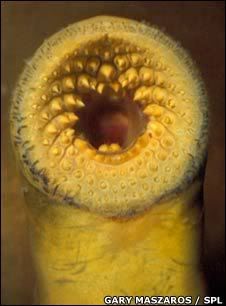 A synthetic "chemical sex smell" could help rid North America's Great Lakes of a devastating pest, scientists say.
A synthetic "chemical sex smell" could help rid North America's Great Lakes of a devastating pest, scientists say.US researchers deployed a laboratory version of a male sea lamprey pheromone to trick ovulating females into swimming upstream into traps.
The sea lamprey, sometimes dubbed the "vampire fish", has parasitised native species of the Great Lakes since its accidental introduction in the 1800s.
The sea lamprey's natural life cycle takes it from birth in a stream to adulthood in the ocean, where it gains its vampirical appellation.
Circular jaws lock on to another, larger fish, and a sharp tongue carves through its scales.
From then on the lamprey feeds on the blood and body fluids of its temporary host, often killing it in the process.
Eventually, the satiated lampreys - both males and females - find a suitable stream to swim up, breed and die.
Unlike salmon, which seek out the stream they were born in, lampreys appear willing to take any stream indicating a suitable breeding place; and perhaps pheromones play a role in identifying streams worth selecting.
Source: BBC
